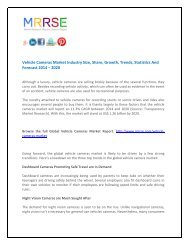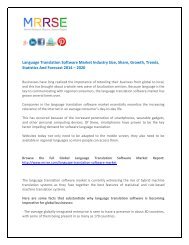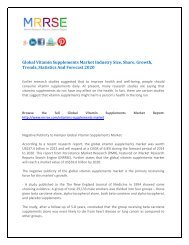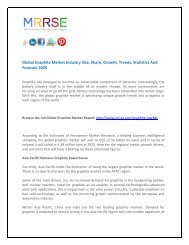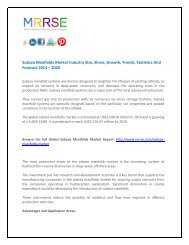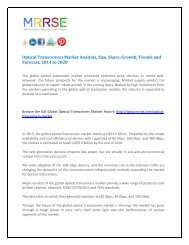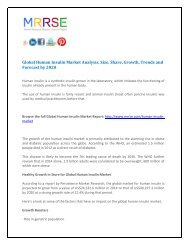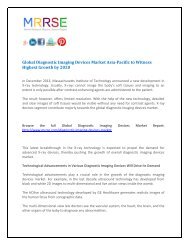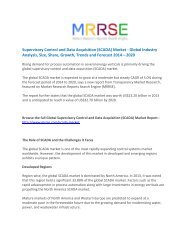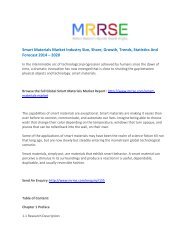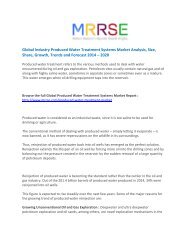Electric Buses Set to Dominate Global Public Transport Scenario
MRRSE.Com announces addition of new report"Global Electric Buses Market Analysis, Size, Share, Growth, Trends and Forecast to 2015-2020"to its database
MRRSE.Com announces addition of new report"Global Electric Buses Market Analysis, Size, Share, Growth, Trends and Forecast to 2015-2020"to its database
Create successful ePaper yourself
Turn your PDF publications into a flip-book with our unique Google optimized e-Paper software.
<strong>Electric</strong> <strong>Buses</strong> <strong>Set</strong> <strong>to</strong> <strong>Dominate</strong> <strong>Global</strong> <strong>Public</strong> <strong>Transport</strong> <strong>Scenario</strong><br />
Alarming air pollution and increasing environmental concerns throughout major cities in China<br />
has forced the Chinese government <strong>to</strong> take prompt steps <strong>to</strong> curtail carbon emission levels.<br />
The Chinese government is highly supportive of elevated uptake of electric buses, which has<br />
substantially contributed <strong>to</strong> the growth of the global electric buses market. <strong>Electric</strong> buses are<br />
broadly regarded as a solution that will help China reduce pollution and road congestion.<br />
Browse the full <strong>Global</strong> <strong>Electric</strong> <strong>Buses</strong> Market Report: http://www.mrrse.com/electric-buses<br />
What Fac<strong>to</strong>rs will Increase Demand for <strong>Electric</strong> <strong>Buses</strong> in China?<br />
<strong>Electric</strong> bus sales in mainland China rose exponentially in the first ten months of 2014.<br />
The projected technological roadmap of the China electric bus market shows accelerated<br />
innovation in the next decade, which will embolden authorities in cities such as Tianjin, Hebei,<br />
and Beijing <strong>to</strong> push bus opera<strong>to</strong>rs <strong>to</strong> endorse pollution-free modes of public transport.<br />
Chinese pure electric buses show a high amount of technological sophistication.<br />
The Chinese were the first <strong>to</strong> replace lithium-ion batteries with the highly reliable and durable<br />
supercapaci<strong>to</strong>rs found in hybrid buses, which enabled the market <strong>to</strong> post robust sales figures.<br />
Supercapaci<strong>to</strong>rs also present benefits such as better safety and higher performance of the<br />
vehicles. Foreign bus manufacturers have invented many other technical improvements, such<br />
as inverters and rapid inductive charging, but at higher costs.<br />
These fac<strong>to</strong>rs will augment the need for pure electric buses in China.<br />
What are the Major Drawbacks still Faced by the China Market for Pure <strong>Electric</strong> <strong>Buses</strong>?
Many electric buses developed in China require the batteries <strong>to</strong> be changed in just two years,<br />
incurring a significant expense. Moreover, some of the technology pioneered in the West as<br />
well as Japan doesn’t favor the Chinese market very strongly, since it can’t be easily<br />
incorporated in<strong>to</strong> the existing technological framework of the China market.<br />
These include battery technology or energy harvesting technology in the form of energyharvesting<br />
shock absorbers, lithium-ion capaci<strong>to</strong>rs, GaN or SiC inverters, flexible<br />
pho<strong>to</strong>voltaics, lithium-metal batteries, swift inductive charging, supercapaci<strong>to</strong>r bodywork,<br />
continuous pickup, and other structural electronics.<br />
However, the Chinese market is booming owing <strong>to</strong> the best of buses having pure electric<br />
powertrains based <strong>to</strong>tally on supercapaci<strong>to</strong>rs, in-wheel mo<strong>to</strong>rs, and battery swapping, as well<br />
as infrastructural support such as gantry charging done at bus s<strong>to</strong>ps.<br />
Browse the full Press Release of <strong>Electric</strong> <strong>Buses</strong> Market : http://www.mrrse.com/electricbuses-market-report<br />
Major <strong>Electric</strong> Bus Launches in China<br />
In 2014, the electric bus giant BYD introduced the Lancaster eBus in China.<br />
This bus was a 60-foot, innovatively enclosed battery-electric bus that could drive over 170<br />
miles on a full charge, and carry about 120 passengers. Another key manufacturer, Ankai,<br />
initiated its fifth-generation electric bus in the dominant cities of China.<br />
A contract was signed by Ankai and Beijing <strong>Public</strong> <strong>Transport</strong>ation Group in order <strong>to</strong> supply<br />
pure electric buses developed by the former <strong>to</strong> the public transport system of Beijing.<br />
Additionally, the JAC Au<strong>to</strong>mobile Group has collaborated with Kunming Municipal<br />
Government <strong>to</strong> promote new hybrid buses in Kunming.<br />
All in all, greener pure electric buses are progressively being adopted by numerous nations<br />
globally, due <strong>to</strong> their superiority over conventional buses in the matters of environmental and<br />
maintenance costs. Analysts have predicted that by 2025, more than 25,000 electric buses will<br />
have been incorporated in<strong>to</strong> public transport systems globally.<br />
Send An Enquiry: http://www.mrrse.com/enquiry/140
Table of Contents:<br />
1. EXECUTIVE SUMMARY AND CONCLUSIONS<br />
1.1. Overview<br />
1.1. Cost trends - China ready <strong>to</strong> pounce<br />
1.2. Market drivers and impediments<br />
1.2. Summary of technical preferences<br />
1.3. Statistics issues<br />
1.3. Regional differences<br />
1.4. China, India and cities<br />
1.4. Successful pure electric buses vs addressable market<br />
1.5. Chinese price/performance<br />
1.5. Radical change<br />
1.6. Truly global market for similar buses<br />
1.6. Forecast 2015-2025 with key orders, technology timelines<br />
1.7. <strong>Electric</strong> bus >8t forecast by powertrain 2015-2025, number, unit value, market value<br />
1.7. Large pure electric buses: first big orders 2014/5<br />
1.8. Weak trend <strong>to</strong> larger buses but not in China<br />
1.8. Forecast by terri<strong>to</strong>ry for buses >8t for APAC, NA, Europe, other<br />
1.9. Market forecast for electric buses
1.12. Technology disagreement<br />
1.13. Fuel cell buses: progress and potential<br />
1.14. Background statistics: au<strong>to</strong>motive industry and buses in general<br />
1.14.1. Au<strong>to</strong>motive industry<br />
1.14.2. School buses<br />
1.14.3. Largest bus manufacturers<br />
1.14.4. Review of 2012-2014<br />
1.15. Effect of 2015 oil price collapse on electric vehicles<br />
2. INTRODUCTION<br />
2.1. Urban logistics trends<br />
2.2. The move <strong>to</strong> electric<br />
2.3. Mo<strong>to</strong>r technology by type of vehicle<br />
2.3.1. Switched reluctance mo<strong>to</strong>rs a disruptive traction mo<strong>to</strong>r technology?<br />
2.3.2. Three ways that traction mo<strong>to</strong>r makers race <strong>to</strong> escape rare earths<br />
2.4. Choice of lithium-ion batteries<br />
2.4.1. 142 lithium battery manufacturers: chemistry, format, sales successes<br />
2.5. <strong>Global</strong> situation: some recent highlights<br />
2.5.1. Australia<br />
2.5.2. China<br />
2.5.3. India<br />
2.5.4. North America<br />
2.6. Europe
2.6.1. UK<br />
2.6.2. Germany<br />
2.6.3. Sweden, Switzerland<br />
2.6.4. ABB intermittent overhead charging<br />
2.6.5. Turkey<br />
2.7. Asia Pacific<br />
2.8. Latin America<br />
2.9. Africa/Middle East<br />
2.10. Number of manufacturers of electric vehicles<br />
2.11. Electrification<br />
2.12. Drivers of change<br />
3. ELECTRIC BUSES IN CHINA<br />
3.1. China au<strong>to</strong>motive industry<br />
3.2. China bus market<br />
3.2.1. China overall bus sales 2012-2014<br />
3.2.2. China Light Bus Market 2013<br />
3.2.3. China Medium Bus Market in 2013<br />
3.2.4. China Large Bus Market 2013<br />
3.3. Move <strong>to</strong> cleaner vehicles<br />
3.4. <strong>Electric</strong> vehicle sales in China 2011-2014<br />
3.4.1. <strong>Electric</strong> bus policy<br />
3.5. Plug-in EV Sales in 2013
3.6. New Energy Vehicles NEV in 2014<br />
3.7. Leapfrogging technology<br />
3.8. IDTechEx assessment of Chinese bus technology<br />
3.8.1. Advanced technology in latest e-buses<br />
3.8.2. Hiccups 3.8.3. China and rare earths<br />
3.9. Chinese fuel cell activity: 35 organisations profiled<br />
3.10. Chinese bus company and regional news 2014-5<br />
3.10.1. BYD<br />
3.10.2. BYD bus progress and plans<br />
3.10.3. 5th New Energy Vehicle Exhibition Beijing Nov 2014<br />
4. SURVEY OF HYBRID BUS MANUFACTURERS<br />
4.1. Overview<br />
4.2. Analysis of hybrid bus manufacturers by location<br />
4.3. 86 hybrid bus manufacturers compared: HQ, bus and e-bus output range, images,<br />
examples and assessment.<br />
5. SURVEY OF PURE ELECTRIC BUS MANUFACTURERS<br />
5.1. Overview<br />
5.2. Analysis of pure electric bus manufacturers by location<br />
5.3. 80 manufacturers of pure electric buses by HQ, bus and e-bus output range, images,<br />
examples and assessment<br />
5.4. Kalsruhe Assessment of E-<strong>Buses</strong> in 2015
6. FUEL CELL BUSES: LESSONS OF 92 TRIALS<br />
6.1. Technology<br />
6.2. Fuel cell bus rollout as planned by Daimler in 2010 but delayed<br />
6.3. Reasons for failure <strong>to</strong> launch<br />
6.4. Third decade of trials<br />
6.5. Ballard Pyrrhic vic<strong>to</strong>ry<br />
6.6. Fuel cell cars in trouble, holding back buses<br />
6.7. New competi<strong>to</strong>r<br />
6.8. Window of opportunity closing<br />
6.9. Catalog of shortcomings<br />
6.10. Advances<br />
6.11. Ballard approach<br />
6.12. Fuel cell size reduces, fewer trials, no rollouts<br />
6.13. Program slippage<br />
6.14. US Targets<br />
6.15. US evaluations<br />
6.16. Key observation<br />
6.17. Daimler program <strong>to</strong>day<br />
6.18. Justified scepticism<br />
6.19. Hyundai progress<br />
6.20. Window of opportunity is closing<br />
6.21. Fuel cell bus trials 1990-2015<br />
6.22. Fuel cell bus trials 2011-2015
6.23. Commitment in Europe<br />
6.24. Commitment in the USA<br />
6.24.1. Some of the fuel cell buses currently in transit service in the US<br />
6.25. Commitment in China<br />
7. EXAMPLES OF INTERVIEWS<br />
7.1. Aleees Taiwan<br />
7.2. Ebusco Netherlands<br />
7.3. Bombardier Germany and Qualcomm USA<br />
7.4. Green GT France<br />
7.5. ITRI Taiwan<br />
7.6. Hyundai Korea<br />
7.7. IFEVS Italy<br />
7.8. Nippon ChemiCon Japan<br />
7.9. Taiyo Yuden and JM Energy Japan<br />
Latest Report:<br />
Sulfur Chemicals Market - <strong>Global</strong> Industry Expert Opinions Analysis, Emerging<br />
Opportunities, Market Size, Share, Growth Drivers, Market Trends, Statistics And Forecast<br />
2015 – 2020<br />
http://www.mrrse.com/sulfur-chemicals-market<br />
Description:<br />
Sulfur is one the most important raw material of the chemical industry.
Majority of sulfur is used in preparation of its derivatives such as sulfuric acid, sodium hydro<br />
sulfide, sodium hydrosulfite, sodium sulfite, sodium sulfide and sodium thiosulfate. Sodium<br />
sulfites include dry and liquid sodium sulfite, sodium bisulfate solution and sodium<br />
metabisulfite.<br />
These chemicals are majorly used in applications like paper, pulp and textile processing, food<br />
and pho<strong>to</strong>graphic industries and in water treatment as reducing and precipitating agent.<br />
Hydrogen Cyanide Market - <strong>Global</strong> Industry Expert Opinions Analysis, Emerging<br />
Opportunities, Market Size, Share, Growth Drivers, Market Trends, Statistics And Forecast<br />
2015 – 2020<br />
http://www.mrrse.com/hydrogen-cyanide-market<br />
Hydrogen cyanide is also known as prussic acid. Hydrogen cyanide is an inorganic compound<br />
that is colorless in nature. Hydrogen cyanide is extremely poisonous liquid which boils at the<br />
slightly above room temperature.<br />
Hydrogen cyanide is weakly acidic and partially ionizes in the water solutions <strong>to</strong> form cyanide<br />
ions. Hydrogen cyanide has a faint, bitter, almond like smell that sometimes is undetected.<br />
Hydrogen cyanide is usually manufactured in large quantities at an industrial scale.<br />
Hydrogen cyanide is an essential and highly valuable precursor for the manufacturing of a<br />
range of chemical compounds from polymers <strong>to</strong> that of pharmaceuticals. Hydrogen cyanide is<br />
included among the chemical welfare (CW) list of chemicals that are known <strong>to</strong> be poisonous in<br />
nature.<br />
About Us:<br />
Market Research Reports Search Engine (MRRSE) is an industry-leading database of market<br />
intelligence reports.<br />
Headquartered in New York, U.S., MRRSE is driven by a stellar team of research experts and<br />
advisors trained <strong>to</strong> offer objective advice.<br />
Our sophisticated search algorithm returns results based on the report title, geographical<br />
region, publisher, or other keywords.<br />
MRRSE partners exclusively with leading global publishers <strong>to</strong> provide clients single-point<br />
access <strong>to</strong> <strong>to</strong>p-of-the-line market research. MRRSE’s reposi<strong>to</strong>ry is updated every day <strong>to</strong> keep its
clients ahead of the next new trend in market research, be it competitive intelligence, product<br />
or service trends or strategic consulting.<br />
Contact<br />
State Tower<br />
90, State Street<br />
Suite 700<br />
Albany, NY - 12207<br />
United States<br />
Telephone: +1-518-618-1030<br />
Email: sales@mrrse.com<br />
Website: http://www.mrrse.com/



